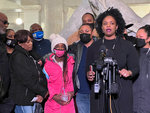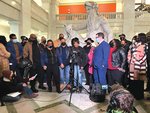

When family members of Amir Locke and community members gathered in the rotunda of Minneapolis City Hall on Feb. 4, 2022, his mother, Karen Wells, said in no uncertain terms: “I believe that he was executed by the MPD and I want the police officer that murdered my son to be prosecuted and fired.”
Officer Mark Hanneman killed Locke in the early morning of Feb. 2 when a Minneapolis Police Department (MPD) SWAT Team entered the apartment where he was sleeping and within nine seconds fatally shot him. The team was executing a search warrant in which Locke was not named as a suspect.
Wells described her son as a law-abiding citizen who did everything he was supposed to do, who was raised with morals and values and loved by so many.
“Everybody that came in contact with him, he had a beautiful spirit and a beautiful smile,” she said. “Never would I have imagined that I would be standing up here talking about the execution of my son by the Minneapolis Police Department.”
Locke’s father, Andre Locke, asked members of the press how many have sons of their own. Seeing some hands raised, he said, “Put yourselves in our shoes… How does that feel, to know that your son is sleeping comfortably, in a safe place, peacefully, and someone takes it upon themselves to choose who lives and who dies”?
“Amir was a bright light. He deserves to be able to shine,” he said.
Nine seconds of body-worn camera footage shows officers using a key to enter the apartment. After the door opens, they begin shouting, “Police search warrant” and “Get on the ground” as they move through the unit. An officer kicks the couch, Locke begins to emerge from beneath his blanket, and he is fatally shot. A still image shows a gun, which Locke was licensed to own, in his hand. His index finger is extended along the barrel, not on the trigger.
Both of his parents knew their son as a deep sleeper.
“What we saw when the officer kicked the couch… [Amir] wasn’t even moving before then. The officer startled him. When he kicked the couch, when he aggravated Amir, when he forced Amir to respond to protect himself, as any law-abiding citizen would do and has the right to do…,” said Andre Locke. “We believe that [the police] executed him, our son Amir. We believe it. And we definitely want to prosecute to the fullest.”
Family members spoke of being very close to one another, with several saying they were present at the hospital when Locke was born.
“You should be outraged,” said his aunt, Linda Tyler. “Not because he’s African American. You should be outraged just because one of your citizens died at the hands of another citizen.”
She said they raise their kids with a certain creed when encountering police: “‘Do this. Put your hands on the wheel. Make sure you look at ‘em eye to eye. Don’t move too soon. Don’t go into your pockets. Just sit still.’ We train our kids up like that because we want them to live just another day.”
To the question of why Locke would have his gun by his side, Tyler said it’s because at home you keep your gun near you, at your bedside.
“That’s what I would do. And so if any intruder comes in, I’m gonna reach for my gun to protect my house and my home,” she said. “Amir was at his cousin’s house, in the sanctity of his house… of course he had his gun by his side, because where else is he gonna put it?”
Community member Marques Armstrong, a licensed gun owner, said Locke showed discipline in handling his gun.
“It took discipline to be startled out of your sleep, dead sleep, with screamin’ and yellin’ and lights and guns and men standing over you,” he said. Armstrong demonstrated with his own hand to show how Locke’s index finger, the trigger finger, was extended along the barrel, not on the trigger. It’s how you draw your gun safely, he explained, until you assess the situation and acquire the target. And only then does the finger drop onto the trigger and squeeze.
“Amir wasn’t in a position to shoot anybody,” said Armstrong. “He was properly trained.”
The Minnesota Gun Owners Caucus issued a statement on Feb. 4 about the incident.
“Mr. Locke did what many of us might do in the same confusing circumstances. He reached for a legal means of self-defense while he sought to understand what was happening,” said Rob Doar, senior vice president of governmental affairs.
Nneka Constantino, Locke’s cousin, called attention to the harm done when authorities advance a narrative that too often criminalizes Black victims. In this case, the initial press release put out by the MPD included a picture of a gun without mentioning that Locke was a licensed gun owner. He was also referred to as a “suspect” four times in the MPD press release, even though he was not named in the search warrant (see “The anatomy of a coverup”). It has the effect of hardening the hearts of those who might be empathetic, said Constantino, but who might write a victim off as “just another thug,” if reclining in the thought that police don’t raid a house for no reason.
“But what we have to reconcile is the fact that no-knock warrants systematically impact Black families and Black people. They do not walk into the families of our White brothers and sisters this carelessly,” said Constantino. “This is a systemic issue. It hits Black families in a different way than it hits the White community, and we all need to be outraged about that.”
The hardest part, said Constantino, is that at press conferences like this, the first thing you hear a Black mother say is, “He was a good kid… He was this. He was that… Because we have to humanize him, and we have to overcome what the Minneapolis Police Department has deposited in you day one, day two.”
Nekima Levy Armstrong of Racial Justice Network said the family’s presence alone dismantles racial stereotypes.
“They always say, ‘Where’s the Black family’”? Gesturing to the extensive family gathered behind her, she said, “Here’s the Black family.”
Protesters take to the streets
Protesters took to the streets with a loud car caravan in downtown Minneapolis the evening of Feb. 4, horns blaring, people leaning out of car windows chanting for justice. The next day 1,000 people poured onto the plaza of the Hennepin County Government Center, many carrying signs that read “Frey Lied. Amir Died.” Family members spoke to the tightly packed crowd who then marched through downtown streets. Some demonstrators were wrapped in blankets; one held a pillow that read: “Amir Locke Murdered Sleeping while Black.”
Activists called for the officer and Minneapolis Interim Police Chief Amelia Huffman to be fired and for the mayor to resign.
On Feb. 6, a car caravan/funeral procession rolled up to Chief Huffman’s residence, where demonstrators placed in the snowbanks small crosses bearing Amir Locke’s name and small red hearts. Live video coverage showed headlights extending the full length of the street as more cars kept coming.
On Feb. 8 thousands of students in the Twin Cities took part in walkout, which included a march from St. Paul Central High School to the Governor’s Residence.
At George Floyd Square, each of the five fist sculptures at the center of and entrances to the intersection have been wrapped in white comforters. AMIR LOCKE WAS LYNCHED! JUSTICE NOW!! is spelled out on the marquee of the former Speedway; AMIR LOCKE is painted on blankets draped over the concrete barriers in front of the black and white “Icon of a Revolution” portrait of George Floyd.
The killing of Amir Locke happened in the midst of the federal trial of J. Alexander Kueng, Thomas Lane and Tou Thao, the former officers accused of violating Floyd’s civil rights when they failed to intervene during George Floyd’s murder.
“We’re here again in a wholly avoidable situation,” said attorney Jeff Storms, who along with Ben Crump is representing Amir Locke’s family. “Once again, like we’ve seen before, George Floyd should not have been murdered. Daunte Wright should not have been killed by Kim Potter… Everyone knows about the dangers of no-knock warrants. From Breonna Taylor and so many others who have died that way. What’s it gonna take for the lesson to be learned? How many more people have to die before we not only enforce policies but implement them?”
On Feb. 4, Mayor Frey placed a moratorium on no-knock warrants, though they would still be allowed in limited circumstances. He vowed to work with national experts DeRay McKesson and Dr. Pete Kraska of Eastern Kentucky University who helped shape Breonna’s Law in Louisville.
The Bureau of Criminal Apprehension is investigating the case. Minnesota Attorney General Keith Ellison is reviewing the case alongside Hennepin County Attorney Mike Freeman.
Comments
No comments on this item Please log in to comment by clicking here